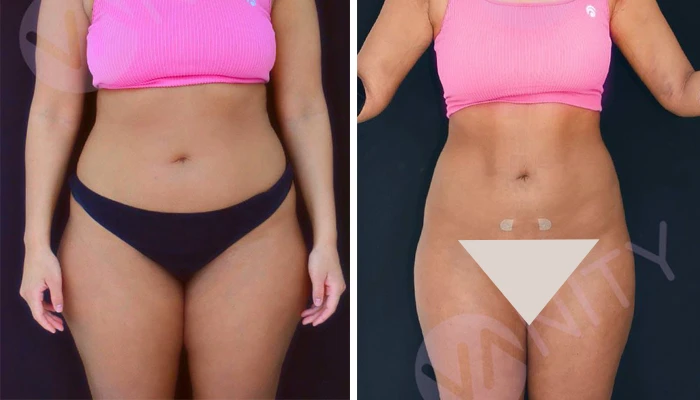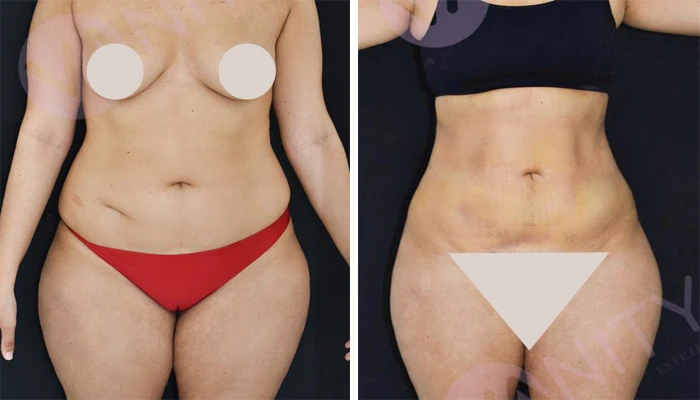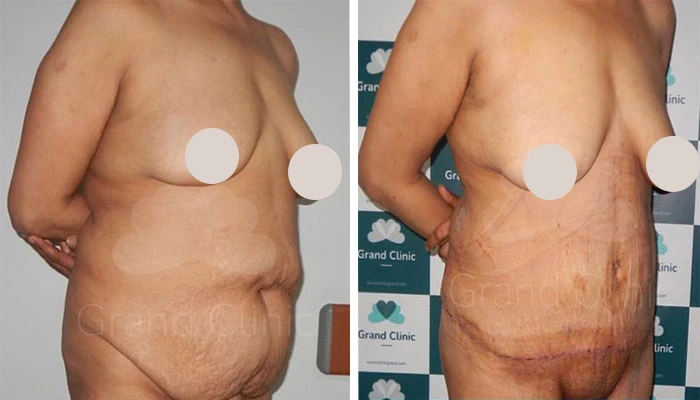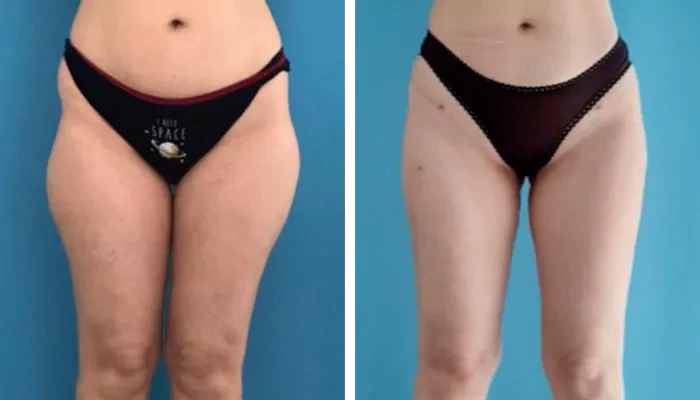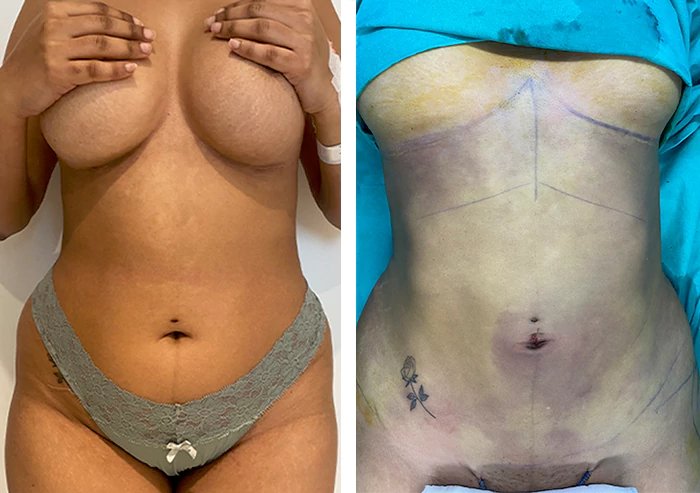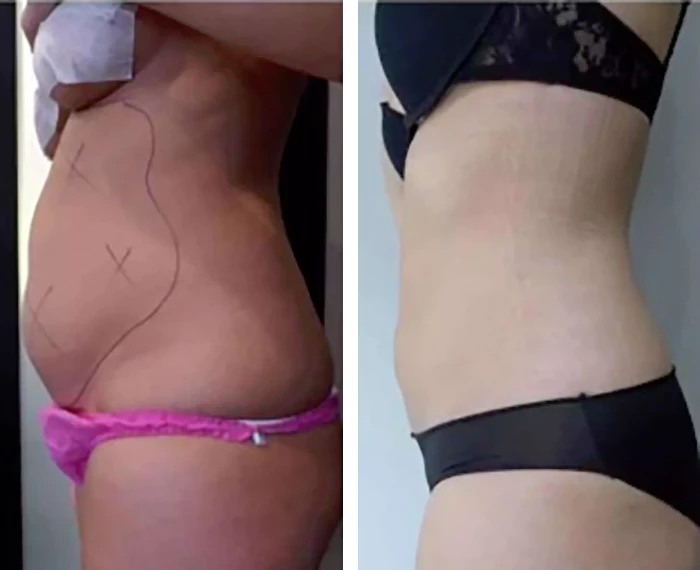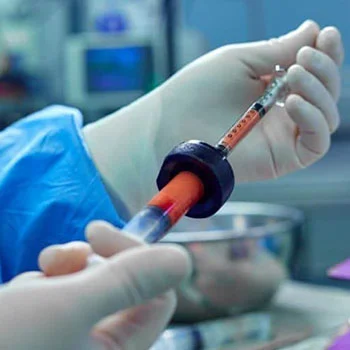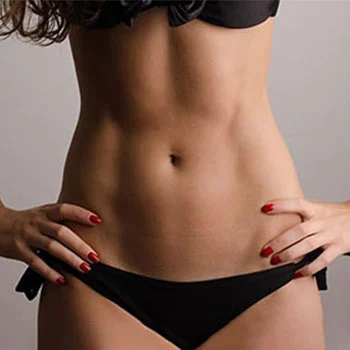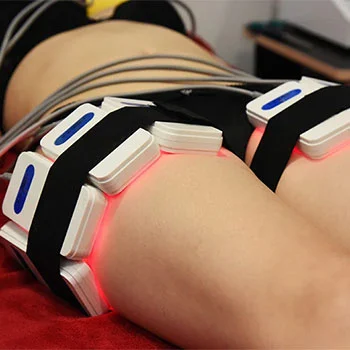What is liposuction?
Liposuction is a general term for a range of cosmetic procedures involving the removal of fat cells from the body using a cannula (a type of needle) attached to a suction machine. More technical terms including ‘lipoplasty’ and ‘lipectomy’ are occasionally used by plastic surgery professionals for liposuction, but it may also be sometimes called by the trademark of the machine used for the procedure.
This article tries to explain everything you need to know about liposuction, including types, how it’s done, benefits, side effects, recovery, and more.
Why liposuction?
Nobody likes a round belly, a double chin, or love handles. But staying fit and slim all the time is no easy feat. It requires a healthy diet and regular exercise.
The sedentary lifestyles of many people today are causing them to run to fat. The accumulation of excess fat in areas like the waist, stomach, arms, legs, etc. makes the body get out of shape and lose its attractiveness. People who don’t have the time to do adequate physical activity to burn the unwanted fat pockets they’ve got under the skin are probably struggling to find a way to get rid of them.
Even some of those who get daily exercise and maintain a healthy diet may still have issues with shedding some of the fat highly resistant to exercise and diet. Liposuction is a great solution for these groups of people. It is an effective way to get rid of local fat deposits that are hard to lose.
Who are good candidates for liposuction?
First off, liposuction isn’t going to help you lose weight, so it should not be considered a weight-loss procedure. Liposuction is a body reshaping procedure that is best for those with normal weight or those who are slightly overweight with localized body fat in specific areas.
In general, a good candidate for liposuction surgery is an adult who:
- Is within 30% of their ideal weight
- Has tried non-surgical options (diet and exercise) to burn unwanted fat but failed to get rid of it
- Has good muscle tone and skin elasticity and firmness
- Has a positive outlook and realistic expectations
- Has good health with no medical conditions that may hinder healing
- Is a non-smoker
Specialists don’t recommend lipo if you:
- Are obese or overweight and expect to lose weight through liposuction
- Have heart disease, diabetes, blood flow problem, weak immune system, or medical conditions that could interfere with healing
- Have poor skin elasticity
- Want to have liposuction to get rid of your cellulite or loose skin (liposuction isn’t a treatment for cellulite and saggy skin)
- Are overly anxious about the side effects and complications of the procedure
What is the best age for liposuction?
Although age is not a big factor in the qualification of an individual for liposuction, as the elasticity of older people’s skin tends to be lower than that of younger people, the results of their lipo contouring procedure may not be as good as those in with younger ages. Therefore, the best age for liposuction is between 18 and 35, as long as the individual has good health and good skin elasticity.
What liposuction can and can’t do
Liposuction can make an enormous difference to your physique and self-confidence, but it can’t do everything. Here is what liposuction can and can’t do:
What lipo can do
- Rid you of stubborn fat that you can’t burn with exercise and diet
- Enhance the shape and contour of your body
- Make your body slimmer
- Boost your self-confidence
What lipo can’t do
- Help you lose weight
- Treat your obesity
- Give you a permanent fitness
- Treat your cellulite
- Treat your stretch marks
- Treat your loose skin
How to prepare for liposuction?
Before liposuction surgery, you will have a consultation with your surgeon during which he/she will give you pre-op instructions about preparing for your lipo procedure. He/she will ask you questions about your medical history, any medicines you are currently taking, previous surgery you may have had, and your motives and expectations. It is very important to be straightforward with your surgeon and answer the questions honestly.
Your doctor may ask you to stop certain vitamin supplements and medications such as blood thinners, including ibuprofen and aspirin, as well as stop smoking and drinking at least two weeks before your surgery. You also may be asked to have some lab tests.
You will be probably asked to not eat or drink anything for a period of 12 hours before surgery. It is recommended that you wear loose-fitting clothes on the day of your surgery and bring someone with you to the hospital to run your errands and help you get back home after the procedure.
How is liposuction done?
The first step in a liposuction procedure is anesthesia. It can be done with general or local anesthesia or intravenous (IV) sedation (twilight sleep). Choosing one of these anesthesia types depends on different factors, such as how big is the treatment area and your medical conditions.
General anesthesia will make you completely unconscious during the operation and IV sedation will get you into a deeply relaxed state in which you’ll feel drowsy and won’t feel any pain during the procedure. Local anesthetics may also be administered to numb the surgical areas.
After the anesthetic has taken effect, the surgeon begins the procedure by making small incisions to the target areas, through which he/she will insert a thin hollow tube called ‘cannula’ and dislodge the excess fat tissue with back-and-forth hand motions (traditional method). The fat will then be suctioned out using the suction machine connected to the cannula.
A lipoplasty procedure can last from one hour to several hours depending on the extent of the operation. Throughout the procedure, the surgical team constantly checks your vital signs, including blood pressure, oxygen level, and heart rate.
Once the procedure is completed, you’ll be taken to a recovery room to come around from the anesthetics. You may need to stay in the clinic or hospital for a few more hours so that the staff can take care of you until you are well enough to go home.
Types of liposuction
When it comes to different types and varieties of liposuction, everyone can put together their own long list of procedures that have one thing in common: sucking out fat from the body with a cannula attached to a suction machine.
Based on the technique and the technology used, liposuction can be divided into the following main categories:
Suction-assisted Liposuction (SAL)
Also known as traditional liposuction, this is the oldest and most conventional type of lipo. Suction-assisted liposuction is used to remove fat from various areas including the abdomen, thighs, arms, back, and waist. However, due to its lack of preciseness, it is not suitable for small areas like under the chin.
The advantages of traditional lipo are its lower cost compared to newer methods of lipoplasty and that it’s been performed for years, so most plastic surgeons are completely familiar with it.
Traditional liposuction has some disadvantages too. The first drawback of traditional lipo is that it causes more bleeding and swelling compared with other types of lipo. The second downside is that controlling the fat removal is more difficult in this technique, which may cause skin dimpling and irregularities after the procedure.
This type of liposuction, unlike most of the newer methods, is usually done with general anesthesia
Tumescent Liposuction
In tumescent liposuction, a sterile solution is injected into the target area to make the fat removal easier and with less severe side effects. The solution, which functions as both a local anesthetic and a tissue-firming liquid, is comprised of lidocaine, epinephrine, and saline.
Lidocaine is a strong anesthetic drug that numbs the treatment area, epinephrine temporarily constricts the blood vessels to reduce bleeding during the procedure, and the saline dilutes the solution.
Tumescent lipo has the advantage of milder bleeding and bruising than the traditional method. It can be done for any area all over the body such as the abdomen, buttocks, arms, back, legs, and neck.
The main advantage of tumescent liposuction is less severe bleeding and bruising and thus a shorter recovery time. It also provides smoother results compared with the traditional technique because it is easier to remove the fat due to the effect of the injected solution.
Tumescent liposuction is also called ‘wet’ liposuction as opposed to ‘dry’ liposuction, which is the traditional suction-assisted method. There is also the newer tumescent lipo called ‘super-wet’ liposuction, which involves injecting an evenly distributed, fast-infused solution with a solution-to-fat ratio of 1:1.
Ultrasound-assisted Liposuction (UAL)
Ultrasound has been used in plastic surgery in general, and liposuction in particular, since the late 1980s. In the UAL approach, high-frequency sound waves are focused on subcutaneous fat, which break down fat cells, making it easier to remove them using suction.
Ultrasonic liposuction is typically done for areas with stubborn fat, like the male chest, neck, back, and outer thighs (saddlebags).
The advantages of ultrasound-assisted liposuction include:
- Removing tough fibrous fat in one session that might otherwise require several sessions in other methods
- More precise fat removal
- Lower chance of damaging surrounding nerves and tissues
- Less bleeding and bruising because the fat is liquefied and required less pressure to suction it
- Shorter recovery time
Ultrasonic lipo has some disadvantages as well. It can cause blisters and burns on the skin due to the high-energy rays. Other side effects of ultrasonic liposuction include blood clots, swelling, numbness, temporary bruising, and a tingling sensation. Also, the ultrasound-assisted liposuction may require a larger incision (for inserting the ultrasound probe) than other lipo types, thus leaving a larger scar in the treatment area.
VASER liposuction
VASER (Vibration Amplification of Sound Energy at Resonance) or VASER lipo is an improved ultrasonic liposuction approach that uses ultrasound energy for minimally invasive liposculpture. The advantages of VASER lipo, as stated by its official website, include:
- Less pain, swelling, and downtime
- Enhanced skin retraction
- Decreased surgeon fatigue
- Treating multiple areas in a single procedure
- Less post-operative discomfort
- Results are seen as early as 1 week with precise sculpting
Laser-assisted liposuction (LAL)
Laser-assisted liposuction, also called laser lipolysis or simply laser lipo, utilizes a laser to break down fat to make them easier to remove. In this procedure, the surgeon inserts a small laser under your skin through an incision to melt fat and then suctions it out with a cannula.
Laser lipolysis is sometimes called by the brand names of the machine that is used for the procedure, such as SmartLipo, LipoControl, LipoLite, ProLipo Plus, and LipoTherme.
Laser liposuction has some advantages over the traditional approach. They include:
- Less downtime and faster recovery
- Precise fat removal
- Suitable for different body areas even unusual areas like the face because of the high controllability
- Tightening the skin
- No need for general anesthesia
The disadvantages of laser lipolysis include:
- It may not be suitable for large areas of fat
- There is the risk of skin burns caused by the powerful laser
SmartLipo
SmartLipo is a type of laser-assisted liposuction in which two different frequencies are used, one for breaking down the fat and the other for tightening the skin and promoting collagen production.
SmartLipo is a new liposculpture approach and one of the most precise methods for lipo contouring. One of the main advantages of Smart lipo is its skin tightening capability, which sets it apart from other types of liposuction. Other advantages of SmartLipo include shorter operation time and fast recovery, which can be as short as a few days.
As for the disadvantages of SmartLipo, they are similar to laser liposuction disadvantages mentioned above, i.e. risk of burns and blistering and its limitations for removing large volumes of fat.
Power-assisted liposuction
Power-assisted liposuction (PAL) is a body contouring procedure that uses a special vibrating cannula to remove unwanted fat from the body. PAL is an innovative body-sculpting technique that obviates the need for strenuous manual work to dislodge fat from its place, resulting in reduced fatigue for the surgeon during the operation and a shorter operation time.
Power-assisted liposuction can be performed alone or in conjunction with other methods such as tumescent, laser-assisted, and VASER lipo. PAL is a precise liposuction technique that offers many advantages, including reduced side effects and recovery time, increased fat removal capability, and less operation time.
PAL may also be referred to as MicroAire by some surgeons, which is a brand name for the machine used for this type of lipoplasty.
Water jet-assisted liposuction (Body-jet)
Water jet liposuction (WAL), often referred to as body jet liposuction or simply body jet, and more technically as ‘aqualipo’, is a new body-contouring procedure that makes use of a water-jet system to apply a pressurized stream of water to the fat cells through the head of the cannula to dislodge them more easily.
Water-assisted liposuction is usually performed with local anesthesia as an outpatient procedure and lasts about 30 to 45 minutes per area. Body jet lipo is also typically performed by injecting a tumescent solution to numb the treatment area and constrict blood vessels to reduce bleeding.
Body jet is a minimally invasive lipo contouring procedure that is a great technique for lipo 360 (all areas around the midsection) with advantages that include fewer side effects, less downtime and fast recovery, and long-lasting results.
Lymph-Sparing Liposuction
Lymph sparing liposuction is aimed at treating lipedema, a condition that causes excess fat deposits in the legs and buttocks, mainly affecting women. Lipedema is a painful fat disorder that causes swelling in the lower body that doesn’t indent when pressured, which is called non-pitting edema. Painful legs, spider or varicose veins, and easily bruising legs are other symptoms of lipedema.
Lymphatic sparing lipo is done to remove lipedema fat tissues using different lipoplasty techniques like tumescent and water jet approaches. Before the procedure, decongestive therapy comprised of lymphatic drainage massage, exercise, and compression is provided to minimize pressure and prepare the patient for safer lipo surgery. Your surgeon usually removes and tightens the excess skin left after the suction procedure to prevent the recurrence of fat accumulation.
Liposuction risks, complications, and side effects
No plastic surgery, liposuction included, is free of risks and potential complications. Lipoplasty risks include:
- Blood clots
- Nerve or blood vessels damage
- Infection
- Fat embolism
- Contour irregularities (bumpy skin)
- Changes in skin color
- Deep vein thrombosis
- Fluid accumulation (seroma)
- Reaction to anesthesia
- Damage to internal organs
- Persisting numbness
- Excessive bleeding
- Burns and blisters on the skin caused by contact with the laser or ultrasonic probe
- Lidocaine toxicity
The total complication rate of liposuction is less than 4%, the majority of which being minor and non-life-threatening. By having your lipo surgery performed by a well-trained, experienced surgeon and taking the necessary safety precautions, you can minimize the risks of the procedure.
The risks are higher for people with pre-existing medical conditions such as heart disease, hypertension, and diabetes, as well as smokers. That’s why it’s crucial to talk to your surgeon about your health and lifestyle before the surgery. Lipo risks also increase as the treated areas and the volume of fat removal increase.
Liposuction also has common short-term side effects that are inseparable parts of the surgery. They include:
- Swelling
- Bruising
- Pain
- Numbness
- Mild bleeding
- Fluid discharge from incisions
These lipo side effects are generally temporary and go away in a few days or weeks.
What to expect after liposuction?
Recovering from liposuction varies from patient to patient depending on several factors, including the size of the treated area, type of surgery, age, and individual’s physical health and wellbeing.
If you need to take time off from work or school, be sure to discuss it with your surgeon during your consultation so that you can get a rough estimate of the number of days off you need to take.
Lipo recovery starts immediately after the surgery when you come around from anesthetics. In case the procedure is done under general anesthesia, you might need to stay in the hospital overnight for a full recovery. If you have the procedure done under local anesthesia or IV sedation the initial post-operative recovery will be faster and you normally don’t need to stay in the hospital overnight.
In any case, you need to have someone help you return home after leaving the hospital because the anesthetics and pain medications you take can cause drowsiness and affect your ability to drive.
After the surgery, your surgeon will prescribe medications such as antibiotics to prevent infections as well as painkillers for post-op pain and discomfort. He/she will also prescribe a compression garment for you, which should be used to improve the post-op swelling and healing. Make sure to wear it as instructed by your surgeon as long as required.
In the first week after your lipo surgery, you will have pain, discomfort, swelling, and bruising. During this time, you should take plenty of rest at home and strictly follow your doctor’s instructions as to liposuction aftercare such as nursing your wounds and taking showers.
The pain is expected to subside within the first few days after surgery but the swelling and bruising may remain fairly noticeable for 10 to 14 days, though it takes up to 3 months for swelling to fully subside.
As small nerves fibers may be affected during the operation, it is not unusual to notice some skin sensation problems after a lipo procedure, which will improve as the nerves start to heal. The healing of the nerves may give you a tingling sensation in the meantime.
Generally, liposuction patients are recommended to avoid strenuous physical activities for 4 to 6 weeks following the surgery. This includes exercise and activities that require too much physical energy. Be sure to talk to your surgeon about when to resume exercise and normal activities after liposuction.
Also, before leaving the hospital, ask your surgeons any questions you have about recovery after lipo, such as “When should I come back for a follow-up?”, “Do I need to have the stitches removed? (and when?)”, “When can I bathe or swim?”, and so on.
Liposuction cost
When it comes to liposuction cost, giving an exact figure is impossible. That’s because lipoplasty is a very diverse procedure that comes in different types and also because the number of treatment areas and amount of fat to be removed varies significantly from patient to patient.
The total cost of liposuction surgery is determined by several factors. These are:
- Type and technique of surgery
- Treatment areas and volume of fat removed
- Experience and reputation of the surgeon
- Anesthesia fees
- Hospital fees
- Location of the hospital and clinic (city and country)
- Recovery expenses (garment, medicines, follow-up, etc.)
Prices for a liposuction procedure range from $1,000 to $20,000, with the average cost of a lipo procedure in the United States being $3,548 in 2019, according to the American Society of Plastic Surgeons (ASPS).
You may want to clear up everything about the cost of your liposuction procedure with the provider before arranging the surgery such as whether the price quote given includes hospital and anesthesia fees.
Liposuction results
The post-op swelling after lipo makes it difficult to notice the results in the first few weeks following the surgery. As the swelling goes down, you start to see the results, which normally takes 1 to 3 months.
The results of lipoplasty can last for a long time on the condition that you maintain a healthy weight and have a balanced diet.
FAQs
Is liposuction covered by insurance?
Because liposuction is typically considered a cosmetic procedure it isn’t covered by insurance, unless in rare cases when liposuction is medically required.
Will I have scars after liposuction?
Liposuction is a minimally invasive procedure, that is the incisions made on the body are very small (just enough for the cannula to be inserted), so the scarring after the procedure is minimal. That said, the visibility of the scars left after the procedure depends on the technique of the surgery, treatment areas, and wound healing.
Will fat return after liposuction?
The fat that is suctioned out through liposuction is permanently removed but this doesn’t mean that you will not regain fat in the treated areas. As long as you keep down your weight after liposuction, you can expect that your liposuction results last long. So it is crucial to adopt a healthy lifestyle that includes a balanced diet and exercise.
How much weight will I lose with liposuction?
Liposuction isn’t a weight loss procedure and the amount of weight you would lose after the procedure won’t be significant. In fact, the American Food and Drug Administration (FDA) has put a limit on the amount of fat allowed to be removed with liposuction, which is 11 pounds, equal to 5.92 kg. That said, this doesn’t mean that you can lose that much weight. This is the upper limit and most patients lose less than this (2-4 kg). However, as the procedure targets aesthetically important areas, it has a significant positive effect on the contours of the body.
What is lipo 360?
Liposuction 360 or Circumferential Liposuction is simply a liposuction procedure that targets all the areas in the midsection, including the abdomen, waist, flanks, and back. It is called lipo 360 because of the 360 degrees around the body.
How long does a lipo procedure take to complete?
Liposuction surgery may last from 1 hour to 5 hours, depending on the number of treatment areas, amount of fat to be removed, technique, and other factors. You may want to ask your surgeon to give you an estimate of the time needed for the procedure to be completed.
How long should I wear a compression garment after liposuction?
Your doctor will give you instructions about wearing a compression garment after your liposuction procedure. Doctors typically recommend patients to wear the garment around the clock for 3-6 weeks, except for when they want to take a shower. After that, you may be asked to wear it only at night. As your recovery progresses, you may also need to have the shape and pressure of the garment adjusted.
Is liposuction painful?
As you will be under anesthesia during the liposuction procedure, it won’t be painful while the surgery is being performed. However, after the surgery and as the anesthetic medicines wear off, you may have some pain and discomfort. Your doctor will prescribe pain medications to relieve your pain during the recovery.
Should I have liposuction or tummy tuck?
Liposuction and tummy tuck are different procedures with different goals. If you have excess fat deposits in your abdominal area and have good skin tone, liposuction is best for you. On the other hand, if you have loose hanging skin on your stomach or loose muscles, a tummy tuck is the right option. Sometimes a lipo and a tummy tuck can be done simultaneously to both remove excess fat and tighten sagging belly skin and muscles. Be sure to consult with an experienced specialist to see which procedure is right for you.

